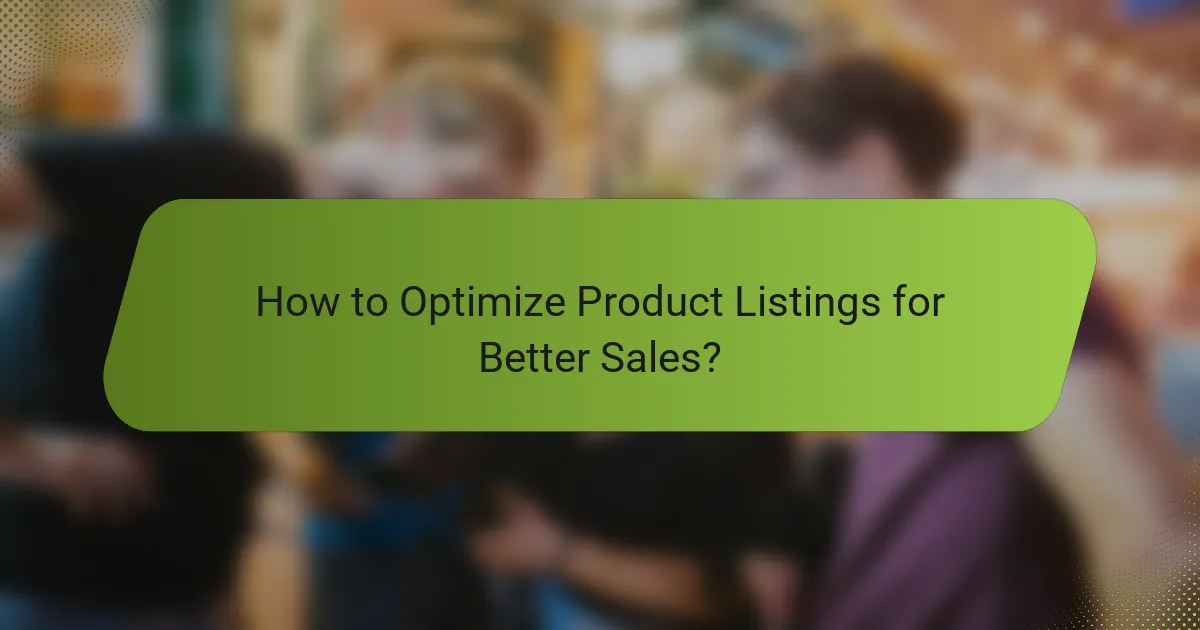Utilizing online marketplaces presents a valuable opportunity for small businesses in America to expand their reach and enhance operational efficiency. By leveraging platforms like Amazon, eBay, Etsy, and Walmart Marketplace, entrepreneurs can increase visibility, reduce marketing expenses, and streamline sales processes, ultimately fostering growth in a competitive landscape.

How Can Online Marketplaces Help Small Businesses in America?
Online marketplaces can significantly aid small businesses in America by providing a platform to reach more customers and streamline operations. These platforms enhance visibility, reduce marketing costs, and simplify sales processes, making it easier for small businesses to thrive in a competitive environment.
Increased visibility
Online marketplaces enhance the visibility of small businesses by placing their products in front of a vast audience. This exposure is crucial, especially for new businesses that may struggle to attract customers through traditional means.
Utilizing popular platforms like Amazon, eBay, or Etsy can lead to increased brand recognition. Small businesses should optimize their listings with high-quality images and detailed descriptions to maximize their visibility on these sites.
Access to a larger customer base
By joining online marketplaces, small businesses gain access to a much larger customer base than they would typically reach through local sales alone. These platforms attract millions of users, allowing businesses to tap into diverse demographics across the country.
For example, a handmade jewelry business on Etsy can connect with customers nationwide, rather than just those in their local area. This expanded reach can lead to increased sales and customer loyalty.
Cost-effective marketing
Online marketplaces often provide built-in marketing tools that can be more cost-effective than traditional advertising methods. Many platforms offer promotional features, such as sponsored listings or discounts, which can help small businesses reach targeted audiences without a hefty budget.
Small businesses should take advantage of these marketing tools to enhance their visibility and attract more customers. Regularly analyzing the performance of these promotions can help refine marketing strategies and improve return on investment.
Streamlined sales processes
Online marketplaces simplify the sales process for small businesses by handling various aspects such as payment processing, shipping, and customer service. This allows business owners to focus more on product development and customer engagement.
Additionally, many platforms provide analytics and reporting tools that help businesses track sales performance and customer behavior. This data can be invaluable for making informed decisions and optimizing operations.

Which Online Marketplaces Are Best for Small Businesses?
Several online marketplaces can significantly enhance small business growth in America. The best options include Amazon, eBay, Etsy, and Walmart Marketplace, each offering unique features and audiences.
Amazon Marketplace
Amazon Marketplace is one of the largest platforms for small businesses, providing access to millions of potential customers. Sellers can list products directly on Amazon, benefiting from its vast reach and established trust.
To succeed on Amazon, focus on optimizing product listings with clear images and detailed descriptions. Consider using Amazon’s Fulfillment by Amazon (FBA) service to streamline shipping and customer service, though it comes with additional fees.
eBay
eBay is a well-known platform that allows small businesses to sell both new and used items through auctions or fixed-price listings. This flexibility can attract a diverse customer base looking for unique or hard-to-find products.
When selling on eBay, ensure competitive pricing and consider using promotions to boost visibility. Pay attention to seller ratings, as maintaining a high rating can enhance credibility and attract more buyers.
Etsy
Etsy specializes in handmade, vintage, and unique goods, making it an ideal marketplace for artisans and crafters. Small businesses can create a personalized storefront that showcases their brand and products effectively.
To thrive on Etsy, focus on high-quality product photography and detailed descriptions. Engage with customers through excellent service and consider participating in Etsy’s promotional tools to increase visibility.
Walmart Marketplace
Walmart Marketplace allows small businesses to sell products alongside Walmart’s extensive inventory, reaching millions of shoppers. This platform is particularly beneficial for businesses that offer everyday items or household goods.
When using Walmart Marketplace, ensure compliance with their listing standards and pricing policies. Leverage Walmart’s advertising options to enhance product visibility and consider the logistics of shipping to meet customer expectations.

What Are the Steps to Start Selling on Online Marketplaces?
To start selling on online marketplaces, you need to follow a series of steps that include selecting the right platform, setting up your seller account, effectively listing your products, and optimizing your presence for search visibility. Each step is crucial for maximizing your reach and sales potential in the competitive online environment.
Step 1: Choose a marketplace
Selecting the right online marketplace is essential for your business. Popular options in America include Amazon, eBay, Etsy, and Walmart Marketplace, each catering to different types of products and audiences. Consider factors such as fees, audience demographics, and product categories when making your choice.
For instance, if you’re selling handmade goods, Etsy may be the best fit, while Amazon is ideal for a wide range of consumer products. Researching each platform’s policies and user base will help you align your offerings with the right marketplace.
Step 2: Create a seller account
Once you’ve chosen a marketplace, the next step is to create a seller account. This typically involves providing personal information, business details, and banking information for payment processing. Most platforms require verification to ensure compliance with their standards.
Be prepared to set up tax information as well, especially in the U.S., where sales tax regulations can vary by state. Completing your profile with a professional appearance can enhance trust with potential buyers.
Step 3: List products effectively
Listing your products effectively is key to attracting buyers. Start by writing clear, concise product descriptions that highlight features and benefits. Use high-quality images to showcase your products from multiple angles.
Consider using bullet points for easy readability and include important details like dimensions, materials, and care instructions. Pricing should be competitive, so research similar products to find a suitable price range that appeals to your target market.
Step 4: Optimize for search
Optimizing your listings for search is crucial for visibility. Use relevant keywords in your product titles and descriptions to improve search rankings within the marketplace. Tools like keyword planners can help identify popular search terms related to your products.
Additionally, encourage customer reviews and ratings, as these can significantly impact your search ranking and credibility. Regularly updating your listings and adjusting your strategies based on performance metrics will help maintain and improve your visibility over time.

What Are the Costs Involved in Selling on Marketplaces?
Selling on online marketplaces involves several costs that can impact your profit margins. Understanding these expenses is crucial for small businesses looking to expand their reach effectively.
Listing fees
Listing fees are charges that marketplaces impose for each product you list on their platform. These fees can vary widely, ranging from a few cents to several dollars per item, depending on the marketplace and the product category.
Some platforms offer free listings but may limit the number of items you can post. It’s essential to check the specific terms of each marketplace to avoid unexpected costs.
Commission rates
Commission rates are a percentage of each sale that the marketplace retains as a service fee. Typically, these rates can range from around 5% to 20%, depending on the platform and product type.
For example, larger marketplaces like Amazon may charge higher commissions for certain categories, while niche platforms might have lower rates. Always factor in these commissions when pricing your products to maintain profitability.
Shipping costs
Shipping costs can significantly affect your overall expenses when selling on marketplaces. These costs include both the fees charged by the marketplace for shipping services and the actual shipping rates you pay to carriers.
Many marketplaces offer discounted shipping rates, but it’s essential to evaluate whether to pass these costs onto customers or absorb them to remain competitive. Offering free shipping can attract more buyers, but ensure you calculate how it impacts your margins.
Advertising expenses
Advertising expenses are additional costs incurred to promote your products on marketplaces. Many platforms offer paid advertising options that can enhance visibility and drive sales.
These costs can vary based on your budget and the competitiveness of your product category. Setting a clear advertising budget and monitoring your return on investment is crucial for maximizing the effectiveness of your campaigns.

How to Optimize Product Listings for Better Sales?
To optimize product listings for better sales, focus on clear descriptions, high-quality visuals, and strategic keyword usage. These elements enhance visibility and attractiveness, leading to increased customer engagement and conversions.
Use high-quality images
High-quality images are crucial for attracting potential buyers and conveying the value of your products. Ensure that images are well-lit, in focus, and showcase the product from multiple angles. This helps customers visualize the item as if they were seeing it in person.
Consider using a white or neutral background to make the product stand out. Additionally, include lifestyle images that show the product in use, which can help customers understand its practical applications and appeal.
When uploading images, adhere to the platform’s guidelines regarding size and resolution. Typically, images should be at least 1000 pixels on the shortest side to allow for zoom functionality, enhancing the shopping experience.
